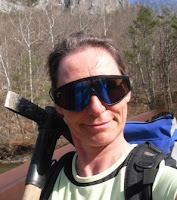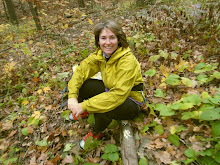People have different reactions when I tell them about the project to improve the climber access trail to the Lower Slabs at Seneca Rocks in which I got involved last year as a crew leader. Most are very supportive and say this is a good thing. Some climbers feel that an improved trail will make the Lower Slabs more popular resulting in increased crowds of topropers who might get in the way of lead climbers, and they feel that is not a good thing.

The trail is designed specifically for climbers to access the Lower Slabs area in a safer and more environmentally friendly manner.
Environmentally friendly
* Climbers have made several trails to the Lower Slabs over time, cutting across from the hiking trail that leads to the observation deck over to the Lower Slabs crag in many different ways, regardless of the ground features and the vegetation. Water running down, rather than across these social trails causes erosion of the hill side. The new trail is designed to help manage erosion.
* The terrain below Scuttle and Discrepancy is extremely steep, with a hill slope of 80%, and has sparse vegetation. With every climber scrambling up to these climbs, the ground below the climbs is eroded away further. New switchbacks leading up from Scuttle to Discrepancy will help stabilize this area. A staging area across the base from Discrepancy will allow climbers not engaged in climbing to prepare gear and rest, out of the way of climbers currently on the face; this will further lessen the disturbance of the steep hill slope, and increase safety.
Safer
* The new trail has better footing than the old trails. Should we ever have to carry out an injured climber from the Lower Slabs area; the better footing on the trail will help us get our injured friend down more quickly.
* Part of the work on the new trail entails eliminating all the other social trails that have been established in this area over time. The discontinued trails are being camouflaged with brush cuttings, leaf litter, and other materials so that they blend in with the surrounding landscape. Having just one clearly identifiable access trail will help any emergency personnel to find the Lower Slabs area more quickly should we ever need to call them for help to evacuate an injured climber. These are just two important ways in which the new trail will improve climber safety.
How I got involved. I believe these efforts will ultimately benefit climbers at Seneca Rocks, and so I got involved in the project in October 2009, during the end-of-season Chili Cook-Off. Diane Kearns, co-owner of the Gendarme, and Ken Dzaack, of Canaan Valley Institute, a contractor hired by Friends of Seneca to design the new trail, presented the project to the climbing community. The idea is that while Friends of Seneca paid to have the trail design done, it is up to climber volunteers to implement the project and build the actual trail. To facilitate this process, Ken Dzaack briefed a small number of volunteer crew leaders early in the spring of 2010. The crew leaders will then explain the project and help an increasing number of volunteers during three trail work weekends to build the new trail and discontinue the social trails.
I signed up right away to be trained as a crew leader. I was excited by the prospect of becoming more involved with a climbing area that has given me so much pleasure and pain. I was also lured by the prospect of learning a new, manual skill. Being an academic, I do very little work with my hands other than typing on the computer keyboard; I thought it might be good for me to try my hand at trail construction instead.
The crew leader training took place on March 21, 2010. It was an amazingly beautiful early-season day at Seneca. Twelve of us, climbers and non-climbers, locals and people from hundreds of miles away, came together to learn about the project. The morning was very cold, and we crammed into the Gendarme with coffee and cinnamon rolls provided by Diane, for an about 2 hour briefing by Ken Dzaack on the fundamentals of trail building, which included a vocabulary sheet and the infamous “forest service typicals,” drawings of US Forest Service recommended trail profiles, as well as a good dose of “Ken’s rules.” After that, we followed Ken and Jeff “the Forest Service guy” to the parking lot at the start of the north face trail, to pick up the tools which the Forest Service is providing for the project. I thought a hammer is a hammer is a hammer…not. Who knew that there are at least six different types of hammer?! After picking out a tool, we had to practice our “tailgate talk.” This is the briefing that the crew leader gives to the crew about the goals and safety concerns of the day’s work, and includes such nifty terms as the “blood circle.” Ken and Jeff then led us up to the start of the climber access trail. We first walked it together, to gain an overview of the entire project and understand what kind of work we should do where.
After that, we broke into three teams, and went to work. It took me all day to build an about one foot high and one foot wide piece of a retaining wall, made out of stones I found along the trail, with Ken and Arthur Kearns supervising and correcting me on and off. I got so involved in my project that the day seemed to end all too soon. The crew leaders returned to the Gendarme for libations, and a Mexican dinner cooked by Diane. It had become clear that each of us has different experience and skill with manual labor. For my part, I could not see myself directing the work needed for building the switchbacks or the landing. But I thought I might be able to work with other volunteers on the more gentle slopes of the 500 feet of trail before you get to Scuttle.

Since we got our crew leader training done on Saturday we did not need to work on Sunday which had been set aside as a rain day. On Sunday then I actually got to climb! With no crowds, Mark “Indy” Kochte and I headed for Skyline Traverse. I had long since wanted to lead the “scary” pitch 2 of the route, but there is almost always a long line for this route on weekends. That Sunday, I finally got her done!
April 10 & 11 was the first trail work weekend with volunteers. My crew included two fellow ECPers, Toni Price and Phil Sidel, plus Phil Hodge, a climber friend from Baltimore. Once again we were blessed with a sunny weekend. But it was still very cold, especially over night.

Toni, Phil and I shared a ride to Seneca on Friday, and arrived early enough to have daylight left. Toni and I headed up to the Lower Slabs because I wanted to review the design document and figure out which stations we should work on, and which tools we would need to take for those jobs. Of course we also took a rope and some webbing, and set up a toprope on Scuttle. It had been 44F downtown Seneca when we headed up for the Lower Slabs. As the afternoon progressed, it seemed to grow steadily colder, and the wind picked up. Nevertheless, Toni and I got a couple of burns in on Scuttle, before we decamped for food and warmth, joining up with Phil for our first Front Porch pizza of the season. It was too frosty to sit on the porch itself; we actually grabbed the table next to the restaurant’s only heater.

Saturday started with hot coffee and banana bread at the Gendarme. Three crews of volunteers were formed, and we headed to the parking lot for the tailgate talks and to pick up our tools from the Forest Service. The day was very beautiful. Redbuds were bursting into bloom all around us, and our spirits were high. Toni Price carried a saw, to remove a small tree in the section of trail we were going to work on, and promptly went to work with it as soon as we arrived at our station. Phil Sidel spent three hours with the sledge hammer, turning big rocks into little rocks for filler material. This earned him a new nickname; we now call him “The Crusher.” Remember that when you next see him! Phil Hodge and I tried to build a step down, using rocks and the filler. I say tried because although we got it done on Saturday, Jeff the Forest Service guy tore it down on Sunday, showing us how we had ignored some important trail building fundamentals.

Trail work is not without danger. Toni and Phil Hodge were moving a large rock into place late that afternoon, when they slipped and got their fingers wedged in. Phil’s looked bad right away, like his thumb would turn into a balloon in no time. He headed down to town to ice it. Not far behind him, we spent Saturday evening in front of the Gendarme. The day had warmed up nicely and we were able to decompress and exchange trail stories over well-earned beers. Diane came through once again with a Cajun dinner for all.

Sunday morning, after loading up on coffee and coffee cake at the Gendarme, we headed up to the Lower Slabs once again. Phil’s finger, thankfully, was not too swollen or bruised to keep him from joining us. We continued to build a set of retaining walls, and consulted with Jeff on a difficult section of the trail for which Ken’s design calls for the addition of four steps. Once again the day flew by all too quickly. A sweaty, exhausted, and happy crew returned to the Front Porch for a final joint meal before heading off into different directions.
Reflections. Working on the trail has been a humbling experience for me. It turned out to be a lot harder to build a sustainable trail of all natural materials than I would have thought. I feel good though; I have learned a lot, and I get much joy from imagining that our retaining walls will still be there a hundred years from now. Well, at least I hope they’ll still be there when I return for more trail work in July. The camaraderie of the volunteers was so worth the sweat and aches and bruises, and the hard work felt really good for the soul.
Please, consider volunteering. There are two more trail work weekends coming up, set for
July 10 & 11, and
September 25 & 26. Please, come and join us. If you cannot do the trail work weekends, there will be opportunities to give to Friends of Seneca during the Cinco the Mayo Party in May and the end of season Chili Cook-Off in October. Another way to help is to purchase the Seneca Rocks 2011 calendar. I have made a wall calendar from my photographs of Seneca Rocks to help raise funds for Friends of Seneca. Calendars make great birthday presents and Holiday gifts. I will have some on hand at future ECP general meetings, and you can also purchase them on the internet.







































